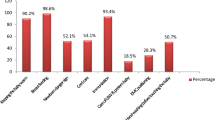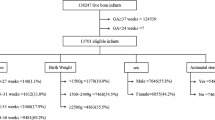Abstract
Objective:
To assess the impact of essential newborn care (ENC) practices on the mortality of neonates delivered at home in Bangladesh.
Study design:
This study used cross-sectional data from the 2011 Bangladesh Demographic and Health Survey. Adjusted logistic regression model was used to examine the effect of ENC practices on neonatal mortality based on 3190 live-born infants.
Result:
Delayed bathing (72 h after delivery) significantly contributed to reducing neonatal mortality. A significant but counterintuitive relation was observed between the dry cord care and neonatal deaths.
Conclusion:
Neonatal mortality may be reduced through emphasizing delayed bathing. Specific guidelines on the cleanliness of the fabric used to dry and wrap newborns, as well as emphasizing the use of clean delivery kits and initiation of immediate and exclusive breastfeeding, may improve neonatal outcomes. Further, the ENC guidelines in Bangladesh should include the application of topical antiseptics to the cord stump.
This is a preview of subscription content, access via your institution
Access options
Subscribe to this journal
Receive 12 print issues and online access
$259.00 per year
only $21.58 per issue
Buy this article
- Purchase on Springer Link
- Instant access to full article PDF
Prices may be subject to local taxes which are calculated during checkout
Similar content being viewed by others
References
WHO, PMNCH A Global Review of the Key Interventions Related to Reproductive, Maternal, Newborn and Child Health (RMNCH). WHO and The Partnership for Maternal Newborn & Child Health (PMNCH): Geneva, Switzerland, 2011.
Seward N, Osrin D, Li L, Costello A, Pulkki-Brännström A-M, Houweling TA et al. Association between clean delivery kit use, clean delivery practices, and neonatal survival: pooled analysis of data from three sites in South Asia. PLoS Med 2012; 9: e1001180.
WHO Pregnancy, Childbirth, Postpartum and Newborn Care: A Guide for Essential Practice. WHO Press World Health Organization: Geneva, Switzerland, 2006.
Pagel C, Prost A, Hossen M, Azad K, Kuddus A, Roy SS et al. Is essential newborn care provided by institutions and after home births? Analysis of prospective data from community trials in rural South Asia. BMC Pregnancy Childb 2014; 14: 99.
Khanal V, Gavidia T, Adhikari M, Mishra SR, Karkee R . Poor thermal care practices among home births in Nepal: further analysis of Nepal Demographic and Health Survey 2011. PLoS One 2014; 9: e89950.
Shamba D, Schellenberg J, ZJ-L Hildon, Mashasi I, Penfold S, Tanner M et al. Thermal care for newborn babies in rural southern Tanzania: a mixed-method study of barriers, facilitators and potential for behaviour change. BMC Pregnancy Childb 2014; 14: 267.
Dettrick Z, Firth S, Soto EJ . Do strategies to improve quality of maternal and child health care in lower and middle income countries lead to improved outcomes? A review of the evidence. PLoS One 2013; 8: e83070.
NIPORT, Mitra and Associates ICF International Bangladesh Demographic and Health Survey 2011. National Institute of Population Research and Training (NIPORT), Mitra and Associates, and ICF International: Dhaka, Bangladesh and Calverton, MD, USA, 2013.
Ministry of Health and Family Welfare. National Neonatal Health Strategy and Guidelines for Bangladesh. Ministry of Health and Family Welfare, Government of the Peoples Republic of Bangladesh: Dhaka, Bangladesh, 2009.
Rutstein S . Wealth Versus Expenditure: Comparison Between the DHS Wealth Index and Household Expenditures in Four Departments of Guatemala. ORC Macro: Calverton, MD, USA, 1999.
Ministry of Planning National Low Birth Weight Survey of Bangladesh, 2003–2004. Bangladesh Bureau of Statistics, Planning Division, Ministry of Planning, Government of the Peoples Republic of Bangladesh: Dhaka, Bangladesh, 2005.
Titaley CR, Dibley MJ, Agho K, Roberts CL, Hall J . Determinants of neonatal mortality in Indonesia. BMC Public Health 2008; 8: 232.
Kumar V, Shearer J, Kumar A, Darmstadt G . Neonatal hypothermia in low resource settings: a review. J Perinatol 2009; 29: 401–412.
Lunze K, Bloom DE, Jamison DT, Hamer DH . The global burden of neonatal hypothermia: systematic review of a major challenge for newborn survival. BMC Med 2013; 11: 24.
Hodgins S, Pradhan Y, Khanal L, Upreti S, Pratap Kc N . Chlorhexidine for umbilical cord care: game-changer for newborn survival? Global Health Sci Pract 2013; 1: 5–10.
Neonatal Mortality Formative Research Working Group. Developing community-based intervention strategies to save newborn lives: lessons learned from formative research in five countries. J Perinatol 2008; 28: S2–S8.
Imdad A, Bautista R, Senen K, Uy M, Mantaring J III, Bhutta ZA . Umbilical cord antiseptics for preventing sepsis and death among newborns (Review). Cochrane Database Syst Rev 2013; 5: CD008635.
WHO Care of the Umbilical Cord. WHO/FHE/MSM—Cord Care. World Health Organization: Geneva, Switzerland, 1998.
Darmstadt GL, Syed U, Patel Z, Kabir N . Review of domiciliary newborn-care practices in Bangladesh. J Health Popul Nutr 2006; 24: 380–393.
Iyengar S, Iyengar K, Martines J, Dashora K, Deora K . Childbirth practices in rural Rajasthan, India: implications for neonatal health and survival. J Perinatol 2008; 28: S23–S30.
Tielsch JM, Darmstadt GL, Mullany LC, Khatry SK, Katz J, LeClerq SC et al. Impact of newborn skin-cleansing with chlorhexidine on neonatal mortality in southern Nepal: a community-based, cluster-randomized trial. Pediatrics 2007; 119: e330–e340.
Blencowe H, Cousens S, Mullany LC, Lee AC, Kerber K, Wall S et al. Clean birth and postnatal care practices to reduce neonatal deaths from sepsis and tetanus: a systematic review and Delphi estimation of mortality effect. BMC Public Health 2011; 11: S11.
Moran AC, Choudhury N, Khan NUZ, Karar ZA, Wahed T, Rashid SF et al. Newborn care practices among slum dwellers in Dhaka, Bangladesh: a quantitative and qualitative exploratory study. BMC Pregnancy Childb 2009; 9: 54.
Osrin D, Tumbahangphe KM, Shrestha D, Mesko N, Shrestha BP, Manandhar MK et al. Cross sectional, community based study of care of newborn infants in Nepal. BMJ 2002; 325: 1063.
Edmond KM, Zandoh C, Quigley MA, Amenga-Etego S, Owusu-Agyei S, Kirkwood BR . Delayed breastfeeding initiation increases risk of neonatal mortality. Pediatrics 2006; 117: e380–e386.
Thairu L, Pelto G . Newborn care practices in Pemba Island (Tanzania) and their implications for newborn health and survival. Maternal Child Nutr 2008; 4: 194–208.
Dhakal S, Chapman GN, Simkhada PP, Van Teijlingen ER, Stephens J, Raja AE . Utilisation of postnatal care among rural women in Nepal. BMC Pregnancy Childb 2007; 7: 19.
Baqui A, Rosen H, Lee A, Applegate J, El Arifeen S, Rahman S et al. Preterm birth and neonatal mortality in a rural Bangladeshi cohort: implications for health programs. J Perinatol 2013; 33: 977–981.
Baschat AA, Cosmi E, Bilardo CM, Wolf H, Berg C, Rigano S et al. Predictors of neonatal outcome in early-onset placental dysfunction. Obstet Gynecol 2007; 109: 253–261.
Nisar YB, Dibley MJ . Determinants of neonatal mortality in Pakistan: secondary analysis of Pakistan Demographic and Health Survey 2006–07. BMC Public Health 2014; 14: 663.
Kabir I, Khanam M, Agho KE, Mihrshahi S, Dibley MJ, Roy SK . Determinants of inappropriate complementary feeding practices in infant and young children in Bangladesh: secondary data analysis of Demographic Health Survey 2007. Matern Child Nutr 2012; 8: 11–27.
Acknowledgements
We thank National Institute of Population Research and Training (NIPORT), Mitra and Associates, and ICF International for allowing to use the data. We thank an anonymous referee in the Journal of perinatology whose comments greatly improved the quality of the paper.
Author information
Authors and Affiliations
Corresponding author
Ethics declarations
Competing interests
The authors declare no conflict of interest.
Rights and permissions
About this article
Cite this article
Akter, T., Dawson, A. & Sibbritt, D. What impact do essential newborn care practices have on neonatal mortality in low and lower-middle income countries? Evidence from Bangladesh. J Perinatol 36, 225–230 (2016). https://doi.org/10.1038/jp.2015.181
Received:
Revised:
Accepted:
Published:
Issue Date:
DOI: https://doi.org/10.1038/jp.2015.181
This article is cited by
-
Examining the influence of correlates on different quantile survival times: infant mortality in Bangladesh
BMC Public Health (2022)
-
Coverage of the WHO’s four essential elements of newborn care and their association with neonatal survival in southern Nepal
BMC Pregnancy and Childbirth (2020)
-
Knowledge, attitude, and practice among mothers about newborn care in Sindh, Pakistan
BMC Pregnancy and Childbirth (2019)



